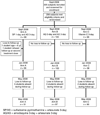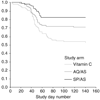Intermittent preventive treatment using artemisinin-based combination therapy reduces malaria morbidity among school-aged children in Mali
- PMID: 19497079
- PMCID: PMC3038653
- DOI: 10.1111/j.1365-3156.2009.02294.x
Intermittent preventive treatment using artemisinin-based combination therapy reduces malaria morbidity among school-aged children in Mali
Abstract
Objective: To assess the efficacy of intermittent preventive treatment (IPT) against malaria in school-aged children.
Methods: This was an open randomized controlled trial of seasonal IPT among school children (IPTsc) aged 6-13 years in Kollé, Mali. The study began in September 2007 and completed follow-up in May 2008. Students were randomized to one of three study arms: Sulfadoxine-pyrimethamine plus artesunate (SP/AS), amodiaquine plus artesunate (AQ/AS) or vitamin C. All students received two full treatment doses, given 2 months apart during the season of high transmission from September to December. Groups were compared with respect to incidence of clinical malaria, asymptomatic parasitemia and haemoglobin concentration.
Results: A total of 296 students were randomized, and retention in the study was 99.3%. Clinical malaria incidence in the SP/AS and AQ/AS arms was reduced by 66.6% and 46.5%, respectively, vs. vitamin C (P < 0.001). There were fewer clinic visits for any cause among the children receiving SP/AS or AQ/AS (P = 0.024). The prevalence of asymptomatic parasitemia was fivefold higher in the vitamin C arm than either SP/AS or AQ/AS at each post-treatment evaluation (P < 0.001). At the end of the transmission period, children treated with IPT had lower rates of anaemia (SP/AS, 17.7%; AQ/AS, 16.0%; vitamin C, 29.6%; P = 0.039).
Conclusion: IPT among school children reduced the rates of clinical malaria, all-cause acute clinic visits, asymptomatic parasitemia and anaemia among school-aged children.
Figures



References
-
- Breman JG, Alilio MS, Mills A. Conquering the intolerable burden of malaria: what’s new, what’s needed: a summary. American Journal of Tropical Medicine and Hygiene. 2004;71:1–15. - PubMed
-
- Castillo-Riquelme M, McIntyre D, Barnes K. Household burden of malaria in South Africa and Mozambique: is there a catastrophic impact? Tropical Medicine and International Health. 2008;13:108–122. - PubMed
-
- Chandramohan D, Webster J, Smith L, Awine T, Owusu-Agyei S, Carneiro I. Is the expanded programme on immunisation the most appropriate delivery system for intermittent preventive treatment of malaria in West Africa? Tropical Medicine and International Health. 2007;12:743–750. - PubMed
Publication types
MeSH terms
Substances
Grants and funding
LinkOut - more resources
Full Text Sources
Medical
Research Materials

